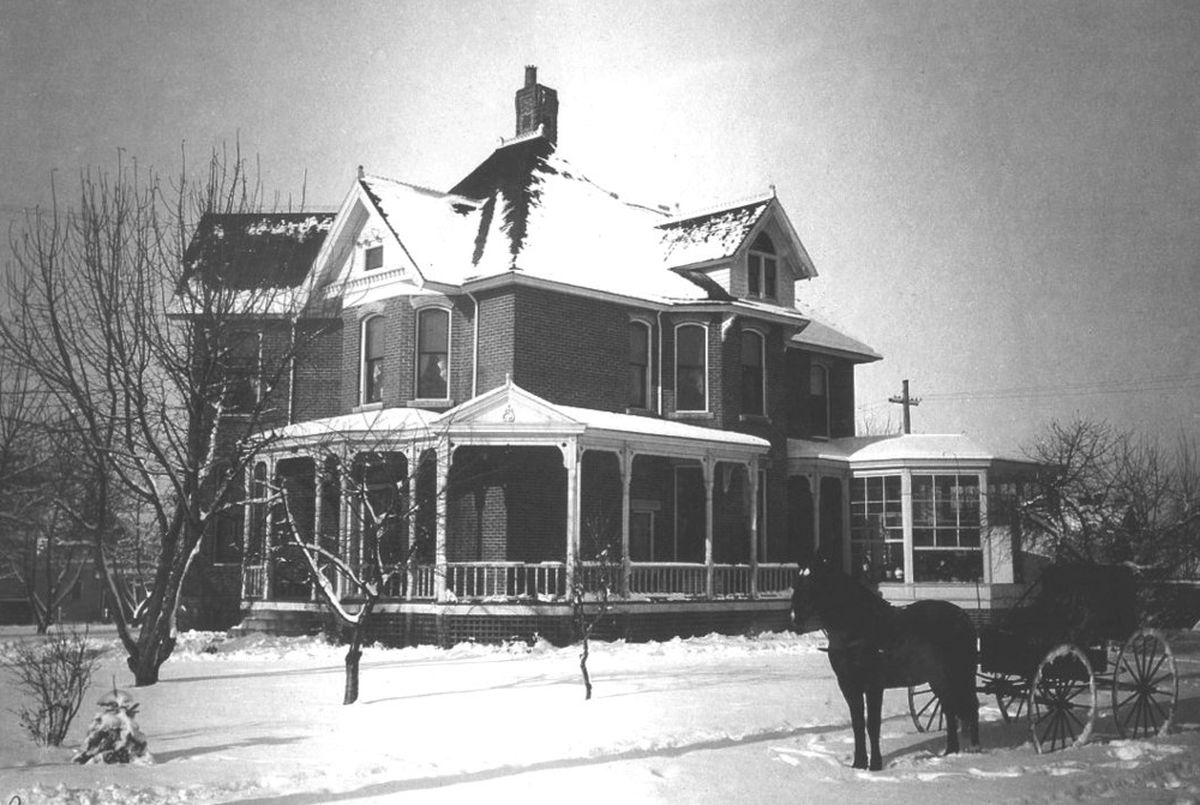Muzzy’s
Restoring 1880s North Side mansion proves both frustrating and fulfilling

As if peering into a crystal ball, Steven Sanford scanned the downstairs foyer of the historic Spokane home he and partner Mike Schultz are painstakingly restoring. “You can imagine they had a few soirees here,” he said, eyes twinkling.
Schultz smiled: “That’s when we wish the walls would talk.”
The walls of their near-North Side Queen Anne Victorian-style mansion aren’t talking. But they ar e whispering, the owners agreed.
And they’re giving up clues to the home’s long and colorful past.
Hiram Newton Muzzy built the two-story brick and granite beauty under the 1880 Homestead Act. It was one of the earliest homes in what then was Spokane Falls, “an ambitious village of 500 souls,” according to the publication Spokane Falls Illustrated.
Muzzy’s mansion reigned over his 160-acre apple orchard in the wild Washington Territory.
President Grover Cleveland conveyed the deed to Muzzy, a lumberman, in 1888, period documents show.
Today the home is the oldest surviving Queen Anne-style house in Spokane, Schultz said.
“With odd angles, 12-foot ceilings, tall arched windows, and wrap-around verandas – the house carries an elegant … presence,” says the Muzzy Mansion Web site Schultz created.
He and Sanford first spotted it 18 months ago. Draped in heavy snow, the place “sang to them” like a romantic Normal Rockwell painting, Sanford said.
They’re 11th in the ownership lineup, according to their Web site.
Perhaps the most significant owners were the late Patrick and Mary Shine, who bought the home in 1905. Shine’s widow remained in the house until 1955, the longest of any previous and subsequent owner.
Shine had served as the city’s treasurer, became a state senator and was named U.S. Ambassador to Ireland just before his 1934 death.
The couple is thought to have entertained a number of influential guests in the spacious home, Schultz said.
By the time Sanford and Schultz entered the picture, the dilapidated home’s 2,600-square-feet of living space had been carved into a maze of dinky one-bedroom apartments, with kitchens and baths.
Undeterred by the scope of rejuvenation, the pair – crowbars at the ready – took possession of the place in January 2006.
Demolition started day one. A closet wall was ripped down, revealing a massive, 130-year-old front door. Adorned with ornate brass hinges and hardware, it stands 8 feet tall and opens into the grand, first-floor foyer.
Four industrial-size Dumpsters later, the two have opened up and rehabilitated a graceful warm, oak staircase, with help from Spokane craftsman Matt Doneen. They’ve also discovered a gentleman’s den and the cramped back stairwell connecting second-story servants’ quarters with the first-floor kitchen, pantry and scullery.
“Nothing says fun on a weekend like opera and gutting things,” Schultz said with a smile.
Salvage yards, antique shops, local lumberyards and eBay are the new favorite haunts.
Armed with their finds, they’ve remodeled both foyers and the kitchen. There, one wall remains in its original condition – coated with 13 layers of wallpaper with touches of the original green paint peeking through, a trend SoHo homeowners follow in their age-old buildings, Sanford said.
The owners predict it’ll take five years to return all 13 rooms to their first footprints and general appearances.
“Every day presents unique sets of challenges that must be addressed and every homeowner, especially of an old house, knows and understands,” Schultz said in an e-mail.
Because restoring a house on this scale seems to be never-ending, the owners said it’s important to temper their frustrations with vision, patience and humor. And to break away from the mess when they feel overwhelmed.
A side benefit? The project’s kinesthetic nature has fueled their interest in the mansion’s previous tenants and Spokane’s development from settlement to city.
To learn the home’s backstory, they’ve collected documents and old maps from the County Assessor’s Office, the Cheney Cowles Museum, the Washington State Archives at Eastern Washington University, the Library of Congress and the National Archives.
Their discoveries have changed their perspective on what it means to revive the mansion, Schultz said.
“History owns it, we’re just the caretakers,” he added.